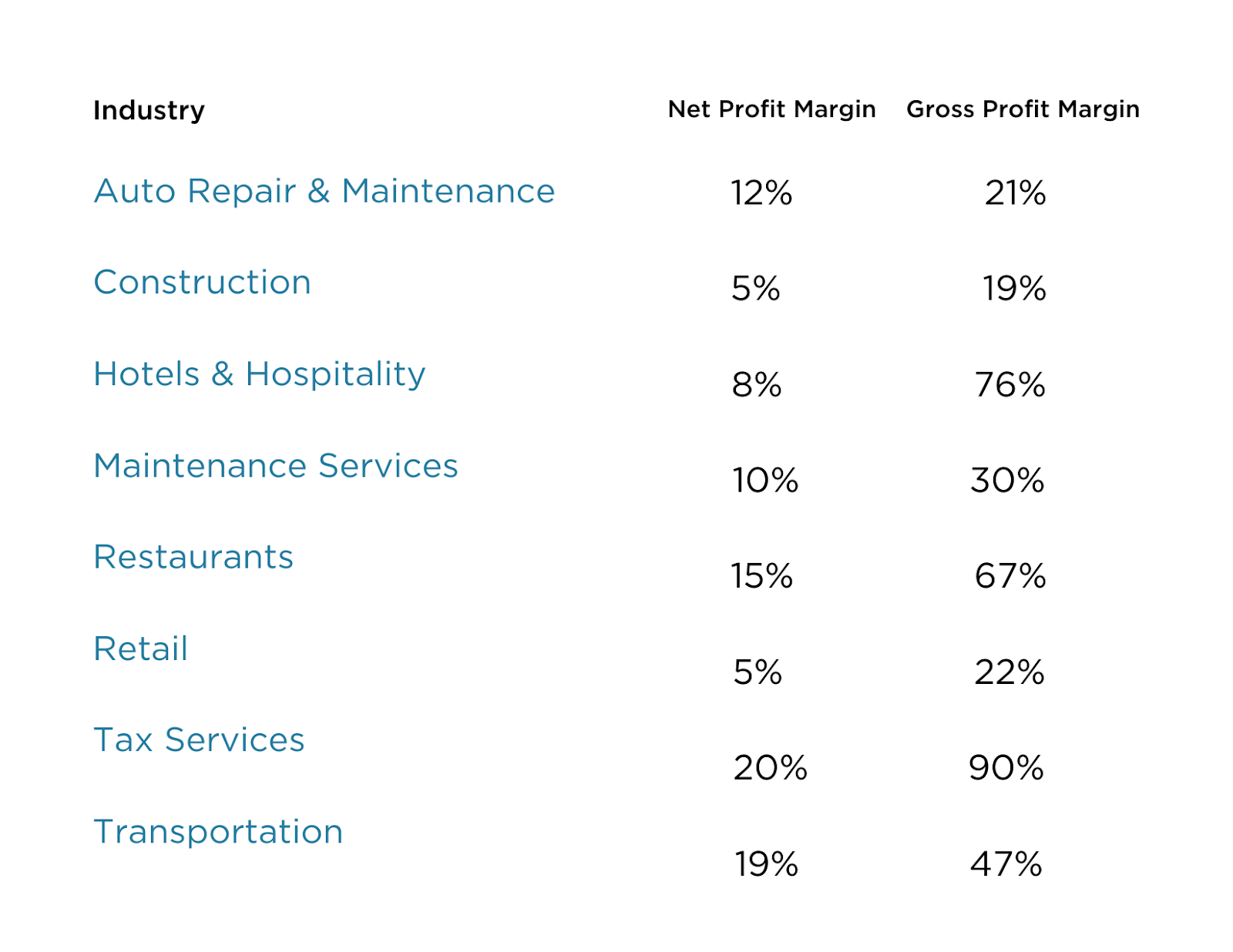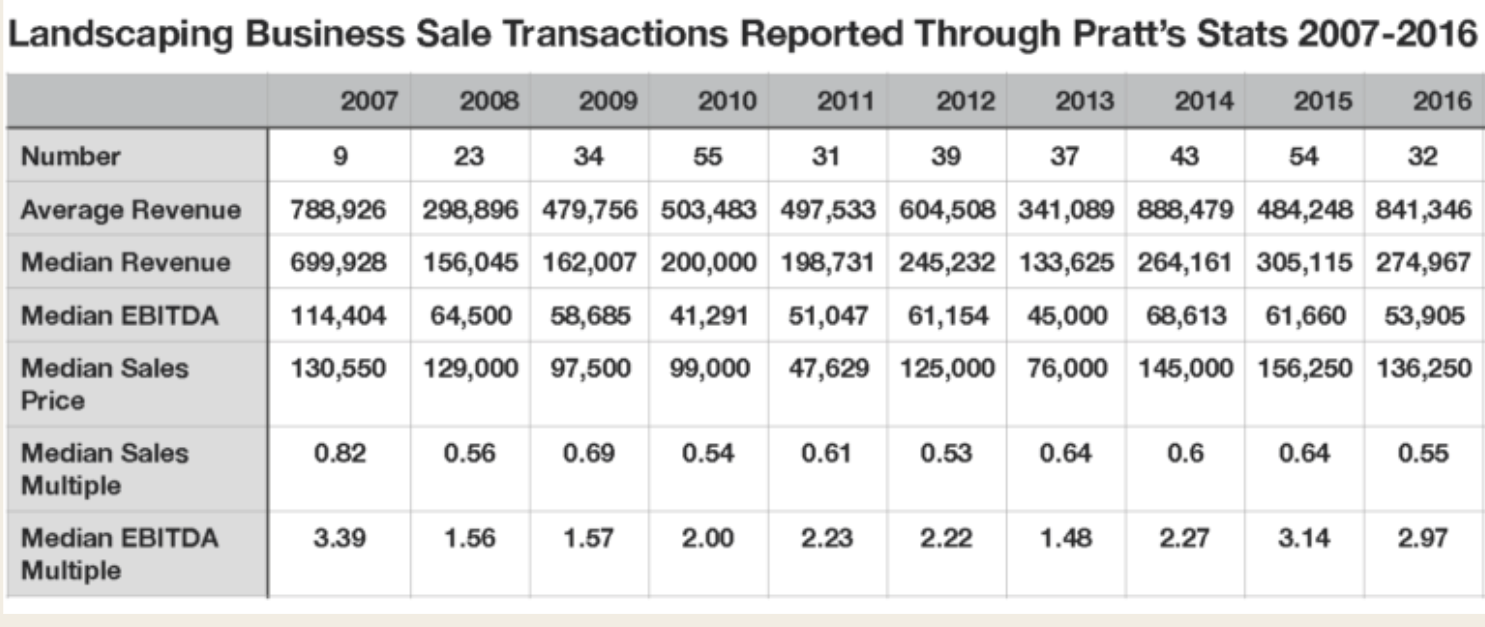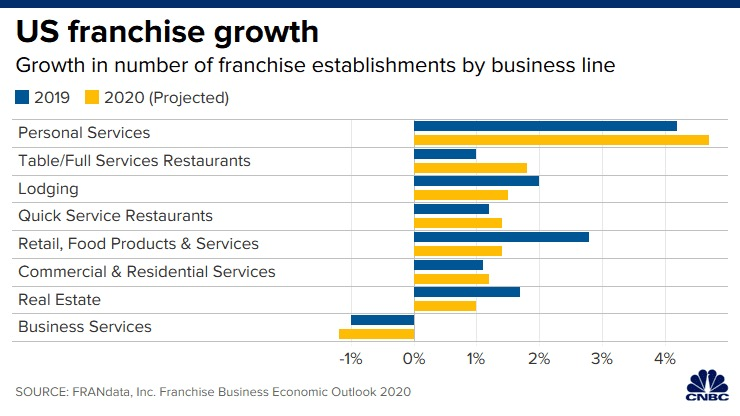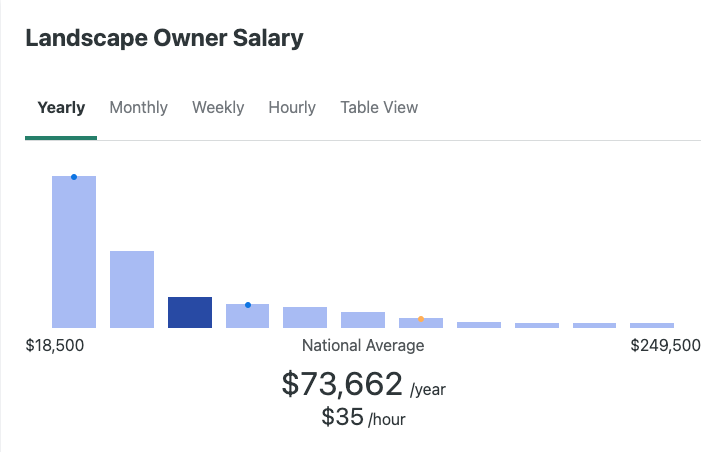
So, you want to know how to start a landscaping business, do you?
The reasons are plentiful. The ability to own your own time, work outdoors with your hands, and contribute to the environment are some obvious ones.
Let’s not kid ourselves. Landscaping is a huge business.
However, knowing that you want to start a successful landscaping business isn’t the same as knowing how to start a landscaping business. You’ll need patience, good marketing skills, and some modern-day marketing techniques to become competitive.
We'll show you how.
What is the Profit Margin of a Landscaping Business
Even if you don’t have that many clients, many landscaping business owners can clear as much as a 45% profit margin. Not bad when you consider that the average profit margins hover in the teens.

How to Start a Landscaping Business in 8 Steps
Truthfully, owning a landscaping business is just like owning any other business in today’s world.
Still, it’s easy to gloss right over them and move on to the fun part: getting clients. Without a proper foundation, though, you’ll spend more and more time going back to fix issues that should have been handled at the beginning.
At the best, it’ll impede your growth. At worst, it could shutter your business.
Better to start things off on the right foot.
Step 1. Decide What Services to Offer
Before you hang out your shingle, ask yourself two questions.
First, what services am I qualified to offer my clients?
Second, what services do I want to offer my clients?
Depending on your target market, you may have several different services you could offer. Some are more profitable than others, while some require special tools and even permits that you may not have.
A lot of landscaping companies on the planet offer simple lawn maintenance (mowing, edging, weeding). If you really want to set yourself apart, consider what kind of bolt-on services you can offer.
- Pruning hedge bushes
- Irrigation system maintenance
- Flower bed maintenance
- Mulching and/or leaf removal
- Fertilizer and weed control
During the winter months, when clients may not need an aggressive lawn program, you could also offer seasonal holiday decorations. If you’re able to maintain your lawn crew, this can be a huge boost to your bottom line.

Of course, you may choose to start small and just offer the basics to your neighborhood and grow with time. Whether or not you’ll be able to depends on if you can carve out a space in your chosen market with a more simple service offering.
Step 2. Choose Your Market
The biggest question you’ll have to answer before entering this space is deciding if you’ll be a commercial or residential landscaper.
You can do both, but it’s much easier to get started in one area and then move to other as the market demands.
Typically, commercial landscaping services handle much larger properties and put a premium on appearance. The grass needs to be as green as possible and the landscaping impeccably manicured in order to provide a good impression for the business.
Because of the scale involved in commercial projects, you’ll have to factor in things like available water sources for irrigation, foot traffic, and even ADA compliance. Walkways must not be impeded by overgrown trees, for instance.
Residential markets, on the other hand, don’t require as much attention to detail. You’ll keep them on a regular maintenance plan, but the focus here is on quantity. You’ll most likely have a higher turnover in your clientele, so consider having a standard service offering that you can offer to your clients. This will make it much easier to add or remove clients as necessary.
Finally, consider the scope of your service area. Do some competitive research on other landscaping companies in your area and see where they operate. Find areas that are underserved and focus on catering to them (if it’s cost-efficient for you to work there).
Keep in mind that just because there may be a lot of competitors in your area, it doesn’t mean that the market is saturated. It may be that the demand is so high that it can support multiple contractors.
In that scenario, the key will be differentiating yourself from others.
Step 3. Get the Appropriate Licenses and Business Insurance
Mowing your own lawn doesn’t require a license, but mowing someone else’s does. At the bare minimum, you’ll need to form an official business (LLC, sole proprietorship, or corporation), have a business license, and take out insurance.
Forming a business entity will help you have the appropriate tax structure (and shield your assets in the event of a lawsuit). But luckily, this process is super easy with a business formation service like NorthWest. For only $39 they provide you with all you need to get your LLC or corporation started.
A license will allow you to offer more services (and, in some cases, be able to operate at all), whereas general liability insurance will protect you in the event of injury to a person or property.

All three of them are really important to have, so don’t skirt around these issues and hope that it won’t happen. At some point, you will have an accident, so make sure these are set up ahead of time.
Finding the specific license requirements for each state can be a headache, so here’s a quick guide for the process, depending on where you live.
Step 4. Set Up Accounting and Tax Information
I get it: Nobody likes to talk about accounting.
(If you do, my hat’s off to you. That’s a passion I don’t think I’ll ever understand).
But having a proper accounting setup is absolutely vital for any business, especially one having to do with landscaping. You’ll have all sorts of costs — labor, maintenance, equipment, etc. — that there has to be some way to track all of it.
Plus, having one in place allows you to know how much to pay yourself. Isn’t that part of what being a business owner is about in the first place?
Fortunately, there are several accounting softwares on the market today that you can use to get your business set up right. Quickbooks is one popular option and integrates directly with TurboTax, so you can kill two birds with one stone.
The actual “how” of setting up accounting for a small business far exceeds the scope of this section, but here are a few things to keep in mind:
- Track everything. That means equipment costs, labor hours, invoices, travel expenses, repair bills, and even your business phone. Most of it is deductible, so consider it as extra money in your pocket.
- Have it automated. It’s nearly impossible to be a full-time bookkeeper and business owner. Software helps, but every once in a while, it’s a good idea to have an outside professional come in for routine checks. Hire a CPA to oversee and provide monthly or quarterly audits of your finances.
- Keep all statements. The last thing you want is to not have the business records in hand in the event you get audited, so make sure you keep all records for the last seven years, at least.
It should go without saying, but I’m not a financial advisor. This part will require some outside help, so ask a professional for more information as to how to set up your business.
One final note. If you ever plan on selling your landscaping business, having a strong financial foundation should increase your selling power. Future owners will want to see that the business was managed well, so take care of the un-fun stuff at the beginning. It’s much easier that way.

Step 5. Create a Pricing Structure
Your pricing structure can make or break your business. A lot of people will start low to drive initial traffic (or because they’re unsure of their skills), then fail to raise them later.
If that’s the case with you, you’ll burn yourself into the ground and make very little money in the process.
It’s always a good idea to start your pricing structure with an understanding of the current services on offer and competitors’ pricing structures. See what their rates are and offer competitive pricing.
I can’t emphasize enough how easy it is to shortchange your services — even unintentionally. You may think that a certain hourly rate is more than fair until you consider operational costs, taxes, and travel time into the equation.
Because of that, many landscapers charge for an initial consultation and then deliver a quote that is based on that specific client. That way, you know exactly how much it’ll cost to handle a certain client.
You may also consider a premium pricing model. Charging more for upsells like hedge trimming and edging doesn’t require additional travel time and can be done with minimal equipment, so it’s worth considering.
Step 6. Purchase the Right Tools
It may surprise you how many tools you’ll need for your landscaping business. Edgers and mowers are a given, but you may also find yourself needing shovels, pruning shears, trimmers, leaf blowers, aerators, gloves, gas cans, and various safety equipment.
That list can really add up in a hurry.
Base your initial equipment checklist on your current (or expected) clientele and factor in a budget line for adding more. As your business grows, you’ll inevitably find out what your specific needs are, so plan ahead.
Also, consider paying more for commercial-grade models. These may be more expensive, but they’ll usually last longer and get the job done quicker. The wear and tear — every landscaper’s Achilles heel — will also be reduced as a result.
Step 7. Plan for the Off-Season
For about 9 months out of the year (depending on where you live), you should expect to have a growing business (literally).
The other three months? Crickets.

Plan ahead for these times by offering off-season landscaping services. This list can include (but is certainly not limited to) the following:
- Holiday decorations
- Snow removal
- Leaf removal
- Gutter cleaning
- Winter mulching
- Pressure washing
These are just a few of the options you have at your disposal. Brainstorm some options with your team.
Winter services will go a long way in keeping your recurring revenue, but they’ll also help preserve your client base and personnel. More than one business lost a significant portion of its business during this time period because it didn’t have a way to engage its assets.
Step 8. Know How to Scale!
Now that your business is off and running, how do you plan on growing it? You can’t expect that your current clients will always stay your clients; you need to expand and grow if you’re going to survive.
There are a few ways that you can consider how to expand your current landscaping business, all of which are worth consideration:
- Expand your service offering. If you started with just a few landscaping services, expand your expertise and upsell to your current customers.
- Expand your service area. Depending on your capabilities, you may have found that there’s no one in your existing market to sell to. Moving into an urban area or adjacent communities may provide a boost.
- Expand your efficiency. Chances are, there are ways to increase your current efficiency. Use automation, shore up tax issues, streamline operations — whatever you need to do to turn the leaky faucet off.
- Expand your expertise. If you’ve tapped out your existing skillset, it’s not a bad idea to hire specific experts in certain areas. Someone that is exceptionally skilled at flower beds, for example, may be a great addition to your team.
- Expand your brand. I’m sure that franchising is the last thing on your mind, but it’s not unreasonable. If you’ve built a strong brand that you think can thrive elsewhere, consider a franchise option to expand to different areas.

How to Start a Landscaping Business: Promotion
Promotion is very much a part of learning how to start a landscaping business.
Whether you intend to take over the world or just your local neighborhood, you’ll need a solid marketing plan. Most people just put up signs on the street corner or rely on word of mouth. While those are nice, they certainly shouldn’t be the extent of your efforts.
These days, you need to be online. Period. Full stop.
Here’s how to get there.
Build a Website
The foundation of every single online effort begins and ends with your website. It’s where you can showcase your skills, increase your search engine presence for passive traffic, and even onboard customers.
It’s so important; we’ve developed an entire blog post around website costs and how to get yours up and running.
Here’s the brief version. You’ll need a few things to get started:
- A domain name. Use Namecheap to search for and buy a domain name that is relevant to your landscaping business. Use a branded name (the name of your business) or one that’s relevant to your niche (like “landscaping”). Ideally, it would include both.
- Website hosting. You need a place for your website to live, and that’s what hosting is for. There are several good options to choose from, but Iridium Hosting has competitive pricing and offers you the flexibility to scale.
- A website. Unless you’re a developer and designer, you’ll most likely rely on a WordPress theme to get your site active. GeneratePress has several to choose from, and you can use Authority Site System to teach you how to build it.
Lean Into Social Media
What used to be a luxury is now a necessity. Half the world is active on some kind of social media, so pick a platform and optimize it.

Facebook is the logical choice. Not only does it have the largest user base, but it allows you to post any type of content you want: video, images, or text. It’s a great way to showcase your current work and connect with people who might be interested.
Not to mention their robust ads platform.
If Youtube is more of your jam, then focus on creating high-quality video content. Tutorials are a great way to increase brand authority. DIY instructables are very popular, as are product reviews (which increase affiliate earnings, too).
Youtube can be really hard to get started with, though, so use a service like TubeBuddy to help optimize your platform.
Connect With Local Businesses
One of the best ways to get your landscaping business going — especially in the early days — is by connecting with local businesses. In doing so, you leverage their reputation to help establish your own.
Just make sure you do quality work, or else you’ll burn that bridge in a hurry.
Unless you’re already familiar with them, most businesses aren’t going to advertise your landscaping company for free. You’ll either have to pay them for space or offer discounts for your lawn care services if they use the other company.
These types of partnerships can be mutually beneficial, so phrase it as such when you approach potential partners. If you can get a link on their page that goes to your website, it’ll also increase your online presence, which helps with local SEO.
Use Word-of-Mouth Marketing
It never hurts to rely on your own reputation to promote your landscaping business. If you have customers that are particularly satisfied with your work, ask them to tell their friends. They may even let you put a sign in their yard so that people driving by can see it as well.
If your happy customers don’t offer to tell others about your landscaping company, you may have to offer an incentive. Something like 10% off your next service if they help you sign a new client may be enough.
Another way to leverage these relationships is by asking for testimonials. A quote from a very satisfied customer provides great social proof for potential clients that may be on the fence about your landscaping business.
FAQ’s About Landscaping Businesses
Experience is the best teacher when it comes to starting a landscaping business. Below are some of the more popular questions that people have when trying to figure out how to start a landscaping business.
How Much Can a Landscaping Business Owner Make?
The national average for landscaping business owners is around $74,000 a year.

This number depends on your state, of course, but in some cases, it can even extend upwards to $250,000 per year.
Of course, there are also outliers that make ten times that, but those are the exception rather than the rule.
If that’s what you’re looking for, it’s a great way to make a living. For those who want to outsource this entire process, however, it’s great passive income to add to your portfolio.
Does It Cost a Lot to Start a Landscaping Business?
You should expect to spend anywhere between $5,000 – $20,000 in startup costs to begin your new landscaping business. This number could go up or down depending on how many initial clients you have, as well as whether or not you’re focusing on commercial or residential clients.
To help alleviate this number, see if you can buy some of these tools secondhand. Absolutely focus on quality — you don’t want to invest in faulty equipment, after all — but there are great deals to be had in online marketplaces.
Once your equipment goes beyond its useful date, look to sell it on the same forums. A lot of people buy equipment to fix up and use for their own lawns, or to start their own lawn care company.
What if I Don’t Have Any Landscaping Experience?
No matter what business you start, starting a business with no experience is going to be much harder than if you know the field. You’ll have to learn the market, make connections, and lean on other experts to help.
That being said, it’s not impossible. As you've seen, you can learn how to start a landscaping business.
Service-based businesses are some of the best types of income generators to outsource precisely because you hire every part of it.
The first person you’ll want to hire is a manager since they’ll be the one providing the experience. From there, focus on hiring a small staff, buying the equipment, and setting up the financial and marketing systems discussed above.
Understand at the outset that you’ll probably make some costly mistakes. The key is to recover, though, and not let it sink you. With any luck, you’ll have a thriving lawn care business in no time.
Thinking About Starting Your Own Landscaping Business?
Working with your hands is an extremely rewarding experience for those who enjoy it, but starting your own business can also provide a great, hands-off way to increase your bottom line.
Knowing how to start a landscaping business is only half the battle, however. You’ll still have to find the people and tools to run it, but those take time. And in the lawn care business, time is your best friend.
The post How to Start a Landscaping Business That’s Built For Success appeared first on Niche Pursuits.

